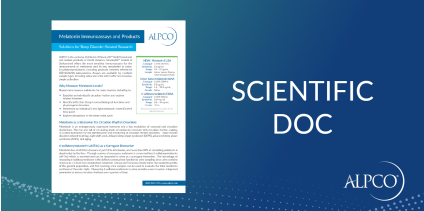January 18, 2022
Melatonin Products for Sleep Disorder-Related Research
 Melatonin is an endogenously expressed hormone present in a wide spectrum of organisms from bacteria to humans. Primarily secreted by the pineal gland, melatonin enters the circulation via cerebrospinal fluid and plays a key role in the regulation of the sleep-wake cycle. Melatonin levels help modulate mood, reproduction, and immune system activities. The rise and fall of circulating levels of melatonin correlate with circadian rhythm, making it a useful biomarker for the identification and monitoring of circadian rhythm disorders. These include disorders related to jet lag, night shift work, delayed sleep phase syndrome (DSPS), advanced sleep phase syndrome (ASPS), and sleep disorders of the elderly. Melatonin, its surrogate 6-sulfatoxymelatonin, and the water-regulating peptide vasopressin are governed by the suprachiasmatic nucleus (SCN). ALPCO offers a growing portfolio of sleep medicine research kits to measure important biomarkers including caffeine, cortisol, creatinine, 6-sulfatoxymelatonin, melatonin, and vasopressin. View a detailed product listing below.
Melatonin is an endogenously expressed hormone present in a wide spectrum of organisms from bacteria to humans. Primarily secreted by the pineal gland, melatonin enters the circulation via cerebrospinal fluid and plays a key role in the regulation of the sleep-wake cycle. Melatonin levels help modulate mood, reproduction, and immune system activities. The rise and fall of circulating levels of melatonin correlate with circadian rhythm, making it a useful biomarker for the identification and monitoring of circadian rhythm disorders. These include disorders related to jet lag, night shift work, delayed sleep phase syndrome (DSPS), advanced sleep phase syndrome (ASPS), and sleep disorders of the elderly. Melatonin, its surrogate 6-sulfatoxymelatonin, and the water-regulating peptide vasopressin are governed by the suprachiasmatic nucleus (SCN). ALPCO offers a growing portfolio of sleep medicine research kits to measure important biomarkers including caffeine, cortisol, creatinine, 6-sulfatoxymelatonin, melatonin, and vasopressin. View a detailed product listing below.Researchers commonly measure melatonin levels to:
- Establish an individual’s circadian rhythm and explore related disorders
- Identify shifts that disrupt normal biological functions and physiological disorders
- Determine an individual’s dim light melatonin onset (DLMO) time point
- Explore disruptions in the sleep-wake cycle
Establishing a Melatonin Profile
Nicknamed the “darkness hormone,” melatonin levels are high at night and low during the day. It is well-established that exposure to light during darkness greatly inhibits melatonin production. The transition from day to evening initiates its production, an event called Dim Light Melatonin Onset (DLMO). Establishing a melatonin profile can help determine an individual’s DLMO time point, which is important in therapeutic applications.6-sulfatoxymelatonin (aMT6s) as a Surrogate Biomarker
Melatonin has a half-life in humans of just 10 to 60 minutes, and more than 90% of circulating melatonin is deactivated by the liver. Through a series of processes, melatonin is converted into 6-sulfatoxymelatonin (aMT6s) which is excreted and can be measured in urine as a surrogate biomarker. Urinary aMT6s levels closely mimic the melatonin profile of the general population, and first morning urine samples can be used to evaluate the melatonin rhythm of the prior night. Measuring 6-sulfatoxymelatonin in urine provides a non-invasive, integrated parameter to assess circadian rhythms over a period of time.Available Sleep Disorder-Related Immunoassays and Products
NovoLytiX offers the most sensitive immunoassays for the measurement of melatonin and its key metabolite in urine, 6-sulfatyoxymelatonin, including products formerly offered by BÜHLMANN Laboratories. ALPCO is now the exclusive distributor of NovoLytiX products in North America. Products for sleep medicine research include:| Item | Catalog # | Sample Type |
| 6-Sulfatoxymelatonin ELISA | 12-EK-M6S-U | Urine |
| Direct Saliva Melatonin RIA | 12-RK-DSM2-U | Saliva |
| Direct Saliva Melatonin ELISA | 12-EK-DSM-U | Saliva |
| Melatonin RIA* | 12-RK-MEL2-U | Serum, Plasma, Urine |
| Melatonin ELISA | 12-MLTN-96-U | Saliva |
| NEW! Serum/Plasma Melatonin ELISA (includes extraction columns) | 12-MLTN-PL-U | Serum, Plasma, Urine, Other fluids. |
| Caffeine ELISA | 12-CAFN-96-U | Other Fluids, Food, Plasma, Saliva, Serum |
| Cortisol Urinary ELISA | 20-CORHU-E01-URN | Urine |
| Cortisol ELISA (Saliva) | 11-CORHU-E01-SLV | Saliva |
| NEW! Cortisol (Saliva) ELISA (sensitive) | 11-CRLHU-E01-SLV | Saliva |
| Cortisol ELISA | 11-CRLHU-E01 | Serum |
| Cortisol RIA | 38-CORHU-R96 | Plasma, Saliva, Serum, Urine |
| Creatinine ELISA | 74-CRNHU-E02 | Urine |
| Vasopressin RIA | 12-RK-VPD-U | EDTA Plasma, Urine |
| Vasopressin ELISA (AVP/ADH) | 74-VSPHU-E01.1 | Cell Culture, Plasma, Serum |
| Item | Catalog # | Description |
| Salivette Collection Devices | 12-B-SVC50-U | For simple, hygienic collection and storage of saliva samples. Each box contains 50 units. |
| Saliva Collection Device (for Cortisol and Melatonin) | 12-B-SCDC50-U | For simple, hygienic collection and storage of saliva samples for measurement of cortisol and melatonin. Each box contains 50 units. |
| Melatonin Extraction Columns | 12-B-MECX | For use with 12-RK-MEL2-U and 12-MLTN-PL-U. C18 silica extraction columns available in boxes of 10x10 units for extraction from biological samples. |
| Angiotensin/Vasopressin Extraction Columns | 12-B-AECX | For use with Vasopressin RIA (12-RK-AR1-U). Solid phase extraction containing 500 mg C18 silica in boxes of 100 units for extraction from biological samples. |

